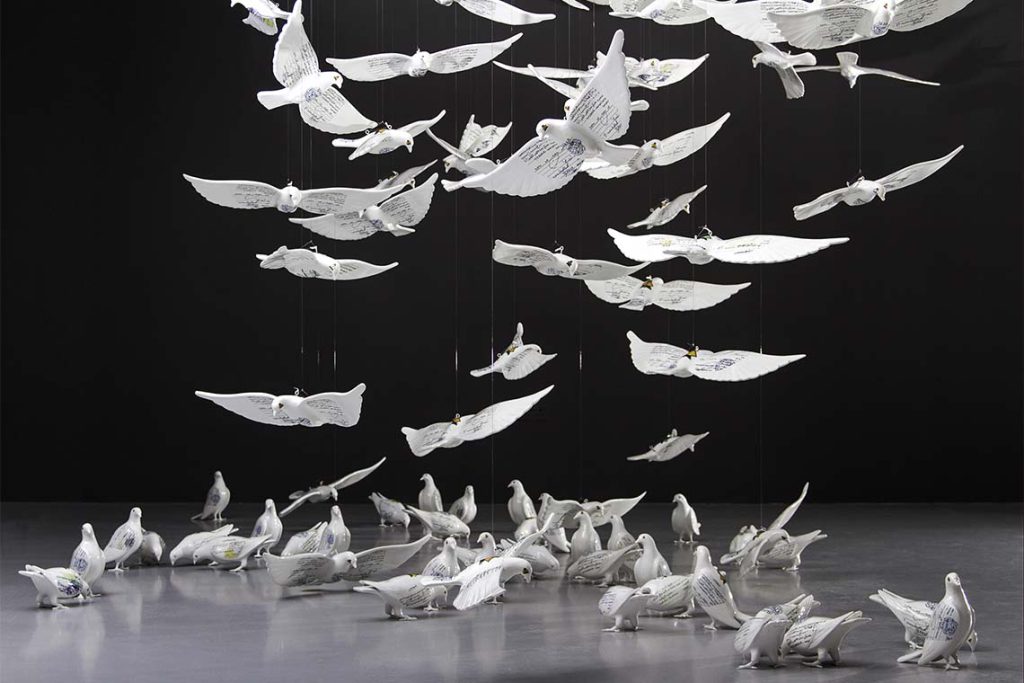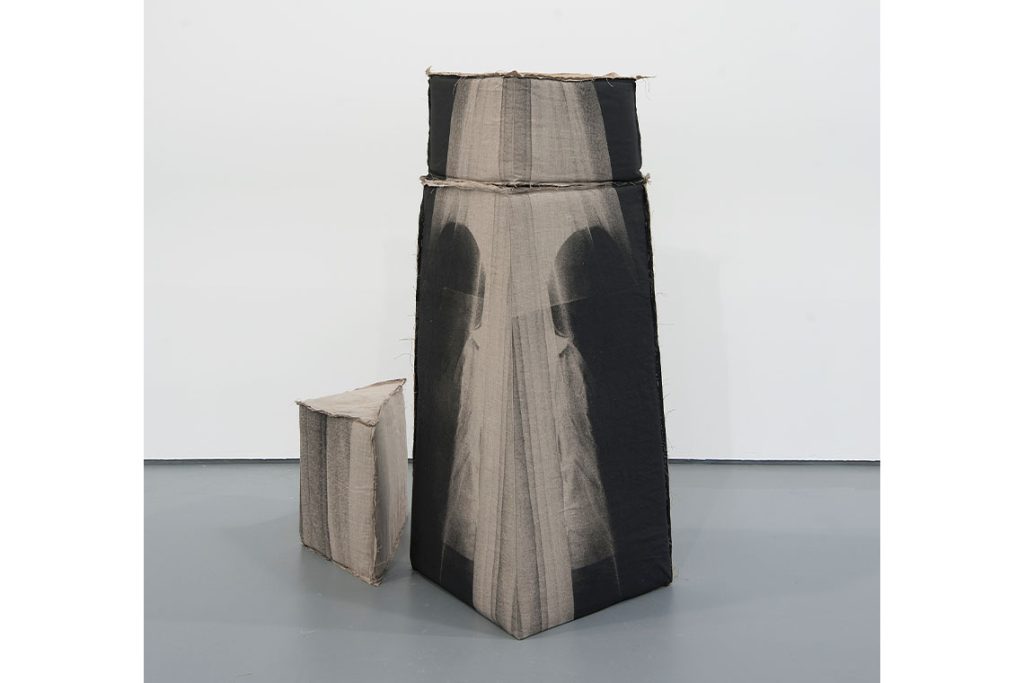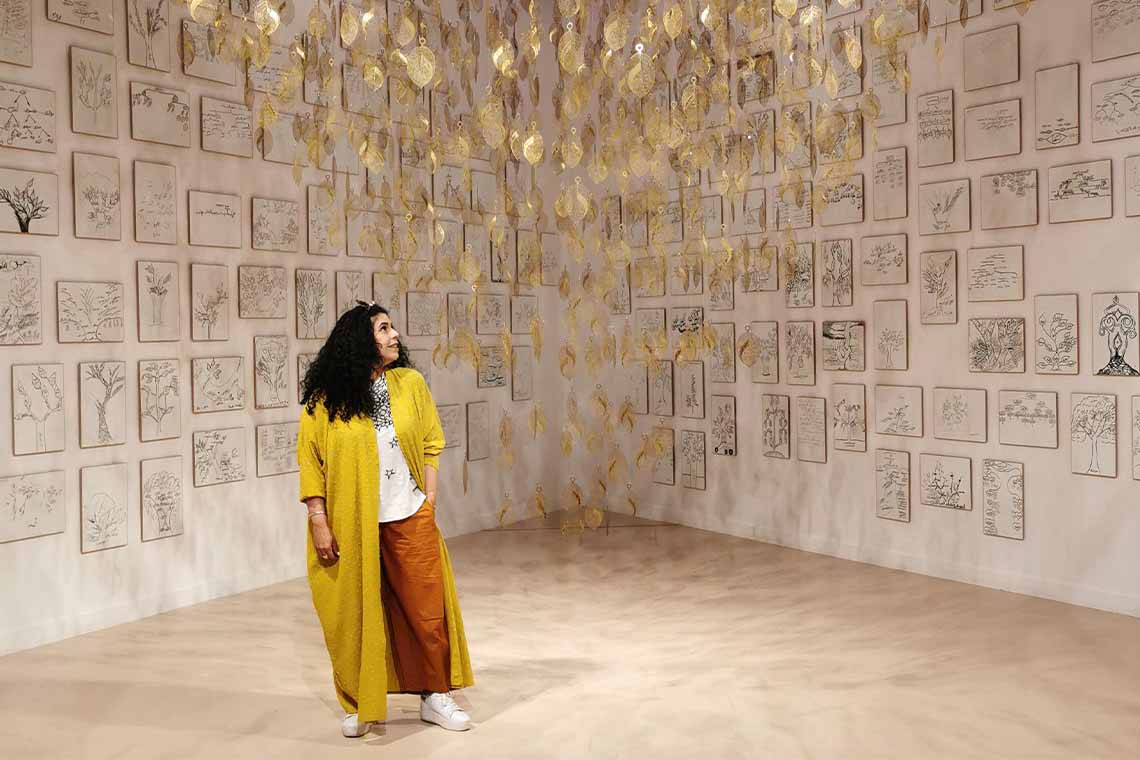The prolific Saudi Arabian artist’s career trajectory seems to have only ever gathered steam. The prospect of slowing down is alien, with new projects, collaborations and installations underway across the globe.
Of the 26 artists from Saudi Arabia exhibiting at the inaugural Diriyah Contemporary Art Biennale, Manal AlDowayan, born in 1973, represents the old guard. She is bringing a 2014 work titled Tree of Guardians, shown now for the first time as a complete work after an unfinished version was exhibited at 21,39 in Jeddah in 2014 and later in the Netherlands and the UK. Pulling our gaze upwards, a flutter of suspended gold leaves are a delicate evocation of a floating tree with no trunk. One of several participatory works for which AlDowayan has made her name, in this case she invited women to take part in a workshop to fill out their matrilineal family trees.
“There’s a taboo attached to women’s names that existed in Saudi Arabia and women were never included in family trees, something that happens all around the world,” she explains. As the participants began drawing, the mood “started off as giggles and laughs” but some women found that they couldn’t remember the names of all their great-grandmothers. “They then realised they might be the only people to preserve these names,” AlDowayan says, “and that they were also at risk of disappearing. There was a bit of a panic in the room, a very interesting energy.”
Describing her participation in the biennale as a “homecoming”, AlDowayan has her eye firmly on the local response. “There’s no audience like the Saudi audience,” she says, “especially the Saudi female. The core of my work is her personal experience.” She fondly recalls being asked by a gallerist in Jeddah to explain a work to a female collector, who quickly assured her “No need, I get it.” By contrast, experiences exhibiting in the West have been mixed and AlDowayan sometimes feels obliged to give context in order to avoid the works being “used to justify an Orientalist mindset or the ‘othering’ of Arab women”. Her subject is not oppressed, she says, but “women who are making a statement through me and my work”.
Since childhood, AlDowayan has had the unique experience of perceiving her country from both an intimate and a foreign perspective. Born in the gated compound run by Saudi Aramco in Dhahran, she was raised in a replica American small town and recalls baseball games and dressing up for Halloween. Women were able to drive and there was no need to wear a veil. AlDowayan exited the gates to visit her grandmother and attend school, adapting to a wholly different lifestyle driven by more conservative religious and social policies. “It was two parallel spaces that had me as a connection, in my mind at least,” she says.

Eventually she would leave the country to study computer information systems at Suffolk University in Boston, where she took lessons in photography and saw art, falling in love with the Isabella Stewart Gardner Museum. Taking up a job at Aramco after graduating was an abrupt change: “It was hard to return as an adult after leaving and tasting independence as a college student.” AlDowayan found a like-minded community among her fellow employees through the Art Group, a collective of amateur creatives. She was granted free run of an old darkroom preserved from the pre-digital era, when it had been used by geologists to develop images of rocks. Later, while studying for a Masters in Systems Analysis in London, she took evening classes in photography at Central Saint Martin’s and the Slade.
A stumbling block to her ambitions, however, was a lack of foremothers on which to model a career. “If you cannot visualise it, then you can’t believe that you could be it,” she says of the lack of female artists in her country at that time. Instead, she sought inspiration in the photographs of Shirin Neshat. “It was the first time I ever saw veiled women look so powerful,” she says. Between 2000 and 2005 she made three of her own blackand- white photography series, culminating in I AM (2005).
Its portraits capture women she knew personally working in a variety of jobs, including a petroleum engineer and an architect. This collaborative format remained in her later projects, for which as many as 500 women would participate from across Saudi Arabia. As to why this communal mode of working came so naturally, AlDowayan wonders “if it’s because the collective voice is more protective? Maybe I was scared to be critical as a lone soldier.”
AlDowayan presented the photographs in a self-curated exhibition for which she printed her own signage, got works framed and produced an artist’s statement. The move evinced an initiative and determination that propelled her into a string of group shows. In 2008 she was spotted by Delfina Entrecanales at an exhibition in Bahrain and invited to a residency at the Delfina Foundation in London. AlDowayan’s request to Aramco for permission to travel was refused. “I was a big personality and it didn’t suit their corporate structure. The patriarchal mindset was like… who does she think she is? They wanted to snuff out that sort of energy,” she says. She was not prepared to lose the opportunity, and quit. “Everyone thought I would be scared, but I just knew this was my destiny.”

These events caused AlDowayan to consider leaving Saudi Arabia, a conflict that is played out in the silkscreen series Landscapes of the Mind (2009). Typical views of the Kingdom are placed against subtly surrealist ink images of hovering eyes and mouths – references to feeling silenced and invisible – and groups of anonymous veiled figures. The latter were taken from the local conservative newspaper Al Yaum, which at the time refused to print women’s faces. It has since put AlDowayan on the cover without a veil.
That many of the more biting political messages in her earlier works are now outdated is pleasing to AlDowayan. “I’m beyond proud of these transformations,” she says. One example is Suspended Together (2011), composed of 200 fibreglass flying doves each imprinted with the permission documents issued by a male guardian that until 2018 were needed for Saudi women to travel. AlDowayan sought out journalists, scientists, academics and others whom “people see as women who are flying and representing and achieving but in reality were frozen by this rule.” The work was initially censored in the catalogue for Edge of Arabia in Dubai, but has since been acquired by the National Museum of Qatar and the British Museum.
Works like these brought AlDowayan international recognition and, in 2015, she was invited to be a resident at the Rauschenberg Foundation in Florida. Her residency coincided with those of Laurie Anderson and Carrie Mae Weems, both heroic ‘elders’ who helped her envision her future. “They were so comfortable in their skin and still making such deep work in their 60s and 70s,” she says.
Now 48, AlDowayan also shows no signs of slowing down. Now You See Me, Now You Don’t, a group of trampolines masquerading as puddles and made in 2020 for Desert X AlUla, is the first work by a Saudi artist to be permanently installed in public. Another iteration opened in October in Ulsan, South Korea and a new public work, Illuminate Me (2021), is now in Ōmachi, Japan. Her three designs for Dior’s Lady Art bag series were launched in Saudi Arabia in December and she soon plans to release her own podcast, Art Talks with Manal. Her followers will not be surprised by these new projects. AlDowayan’s sprawling practice has been fast expanding ever since she first found sanctuary in that abandoned darkroom.



